Because the payroll tax revenues that fund Social Security and Medicare currently exceed the amount paid in benefits, these two programs are generating annual budget surpluses.
But by the time the first of the baby boomers begin to retire, Social Security and Medicare will begin paying out more in benefits than they collect in payroll tax revenues. As a result, taxes will have to rise.
- In contrast to the current 15.3 percent (FICA) tax rate, spending on Social Security and Medicare Part A combined will swell to 23.8 percent of payroll by the time today's teen-agers reach retirement age in 2050, according to the Social Security Administration's intermediate forecast.
- If federal subsidies for the Medicare Part B program and health care benefits funded through programs such as Medicaid and the Veterans Affairs system are also expressed as a percent of taxable payroll, the mid-century burden climbs to 32 percent.
- Thus to keep its promises to people entering the labor market today, the federal government will have to claim almost one-third of the income of future workers – most of whom are not yet born.
Nor is this the worst that can happen. The Social Security and Medicare actuaries also make a forecast based on pessimistic assumptions:
- When today's 18-year-olds reach retirement age, Social Security spending will equal 21.7 percent of payroll – more than twice the current burden.
- When Medicare and other elderly health programs are included, spending in 2050 will equal 54.4 percent of taxable payroll.
- If this projection proves true, we have already pledged more than half the incomes of future workers just to cover benefits for the elderly already included under current law.
- This burden will be even greater if Congress tacks on a new Medicare prescription drug benefit or a long-term care benefit.
Moreover, even the pessimistic projection is by no means the worst that can happen. After 1997, the Medicare trustees made a dramatic and unexplained change in their assumptions, wiping out almost one-third of Medicare's unfunded liability in one fell swoop. Without this sudden surge of optimism, elderly benefits will consume about two-thirds of worker income by mid-century, based on the pessimistic forecast!
Despite all the recent attention paid to Social Security's long-term fiscal insolvency, Social Security is not our biggest problem. Health care is. Indeed, health care spending will outpace Social Security spending by the time today's teen-agers reach the retirement age, according to intermediate assumptions. If the pessimistic projection proves to be true, health care spending will surpass spending on Social Security during the baby boomer retirement years.
The reason for the financial crisis in America's elderly retirement programs is that they are based on pay-as-you-go finance. All payroll tax revenues are spent – the very minute, the very hour, the very day they are received by the U.S. Treasury. Most of these revenues are spent on benefits for current retirees. Any additional amount is spent in other ways or, more recently, to pay down the national debt. But there is no funding of future benefits. No money is being stashed away in bank vaults. No investments are made in real assets. Pay-as-you-go means taxes taken from today's workers pay for benefits government provides to today's retirees. When today's workers reach the retirement age, their benefits will be paid only if higher taxes are collected from the next generation of workers.
What about the trust funds? Unfortunately, these funds have an accounting function, but not a financial function. The funds do not collect taxes. Nor do they disburse benefits. Every payroll tax check sent to Washington is written to the U.S. Treasury. Every Social Security benefit check is written on the U.S. Treasury. Moreover, the Social Security trust fund exists within the U.S. Treasury – not as an independent entity. Thus the issuer of the trust fund's bonds (the U.S. Treasury) and the holder of the bonds (the Social Security trust fund) are the same entity. As a result, the trust fund's special-issue bonds are actually nothing more than IOUs the government writes to itself. To redeem the IOUs in the trust fund, the government will have to raise taxes, increase borrowing or cut other government spending. Ironically, these are the same choices we would face if the trust fund did not exist.
What can be done to save Social Security? Some have suggested "patchwork reforms" that tinker at the margins of the system. These reforms would either cut benefits or raise taxes or both. But they would maintain the pay-as-you-go structure of the current system.
An alternative approach is to move quickly to replace the current system with a funded system. Under this approach, workers would make deposits to funds that invest in interest-earning assets – that can be sold to pay benefits in future years. Under this approach, worker benefits are not dependent on the willingness of future generations to pay taxes.
Instead, each generation would pay its own way.
[page]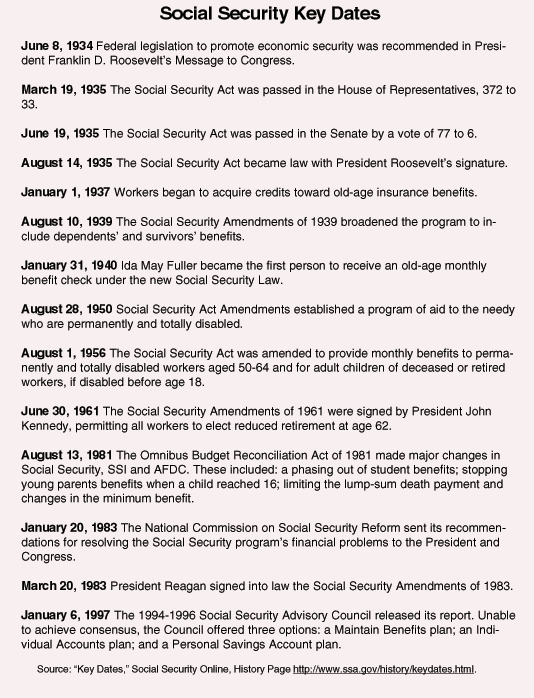
The first Social Security check went to Ida May Fuller, a legal secretary in Vermont, on January 31, 1940. Miss Fuller and her employer each paid only $24.75 in Social Security taxes during the three working years she was covered by Social Security. Yet she lived to be 100 years old and collected $22,888.92 in benefits before she died. Like Miss Fuller, millions of other elderly Americans also have collected benefits far in excess of what they paid in taxes.
But for workers today, the picture is very different. Indeed, most people under 65 years of age will actually receive less in benefits than they contribute in payroll taxes over their working lives.1
"When today's workers reach retirement age, their benefits will be paid only if higher taxes are collected from the next generation of workers."
When Social Security was initiated in 1937, workers contributed only 2 percent (half from the employer and half from the employee) of the first $3,000 of wages. The program only paid for retirement pensions and only covered workers who contributed. Since then, Social Security has become considerably more expensive. What started as a mild contribution for retirement pensions now claims 12.4 percent of the first $80,400 for pensions, benefits for family members and benefits for disabled workers, plus an additional 2.9 percent of all wages for Medicare. And taxes will have to rise even higher if the government is to pay promised benefits to future retirees.
From its inception, Social Security has been a pay-as-you-go system. Pay-as-you-go means taxes taken from today's workers pay for benefits government provides to today's retirees. When today's workers reach retirement age, their benefits will be paid only if higher taxes are collected from the next generation of workers. But how high will future taxes have to be?

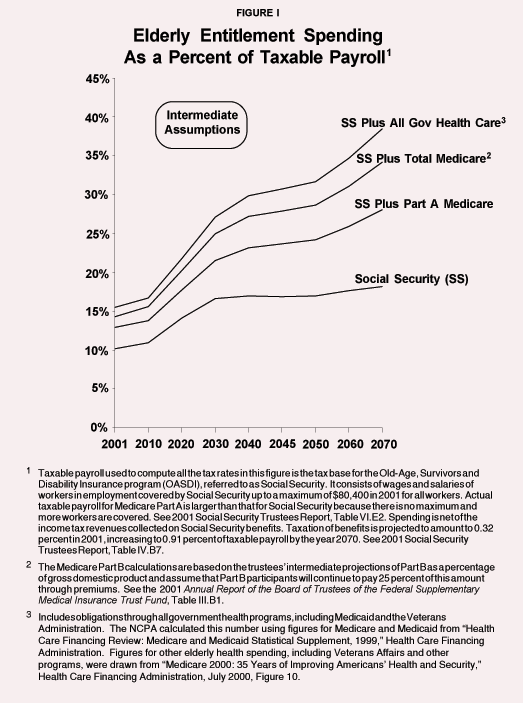
Each year actuaries with the Social Security Administration (SSA) and the Health Care Financing Administration (HCFA) report in detail on the status of Social Security and Medicare and make projections for the next 75 years, based on a number of demographic and economic assumptions. The actuaries make three sets of projections: an intermediate forecast, a low-cost (optimistic) forecast and a high-cost (pessimistic) forecast. What follows is a brief summary based on the most recent reports.2
"In addition to Social Security, the elderly also receive Medicare & other medical benifits."
Social Security. As far as we care to look into the future, Social Security spending will rise relative to our national income and will do so almost continuously under any set of reasonable assumptions.
- Currently, spending on Social Security equals about 10.2 percent of the nation's total taxable payroll.
- Under the SSA's intermediate forecast, by the time today's 18-year-olds reach retirement age in 2050,3 spending will equal 16.8 percent of payroll – an increase of more than two-thirds. [See Figure I.]
Social Security Plus Medicare Hospital Insurance. Social Security is not the only elderly entitlement, however. Future workers will also have to pay for Medicare. Medicare Part A, or Hospital Insurance (HI), primarily pays for hospital bills.
- Currently, spending on Social Security and Medicare Part A combined equals 12.7 percent of payroll.
- According to the SSA's intermediate forecast, by 2050 spending on Social Security and Medicare Part A will swell to 21.7 percent of payroll.
"By mid-century, the federal government will need almost a third of workers' incomes just to pay benefits for the elderly already included in current law."
Social Security Plus Total Medicare. Medicare Part B, or Supplementary Medical Insurance (SMI), covers physicians' fees and other outpatient expenses. It is funded by beneficiaries' premium payments (about 25 percent) and a subsidy from the federal government's general revenues (about 75 percent). The calculations included herein assume that beneficiary premiums will continue to cover 25 percent of Part B costs and that Part B expenses will grow at the same rate as Part A expenses. Further, in order to facilitate comparison, we are expressing this burden as a percent of taxable payroll, along with Medicare Part A.
- Currently, spending on Social Security and total Medicare combined equals 14.2 percent of payroll.
- According to the SSA's intermediate forecast, by mid-century spending on Social Security and total Medicare will increase to 28.2 percent of payroll – more than one-fourth of workers' incomes.
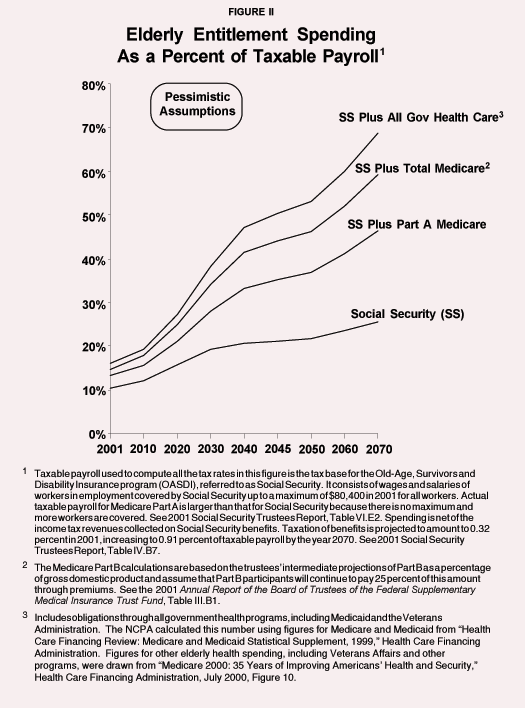
Social Security Plus Total Health Care Expenses. Medicare is not the only way government provides medical benefits to the elderly. To determine how high future expenditures on elderly retirement and health care benefits will be, spending on other programs that provide benefits to the elderly – like Medicaid (for the poor) and the Department of Veterans Affairs (VA) – must be included.
- An NCPA forecast assumes that the elderly will continue to pay out-of-pocket the same share of health expenses they pay today and that taxpayers will pay the difference.4
- Based on the Social Security Administration's intermediate assumptions, we estimate that by 2050 the burden of all elderly entitlements will rise to 32.3 percent of payroll.
"Under the pessimistic forecast, elderly entitlements could consume more than half of payroll."
Thus by mid-century, the federal government will need almost a third of workers' incomes just to pay benefits for the elderly already included in current law. Moreover, this burden comes on top of all the other services taxpayers will be expected to fund – from national defense to roads and bridges to salaries for teachers and police officers.
Pessimistic Forecast. Nor is this the worst that can happen, as Figure II demonstrates. The pessimistic projections developed by the Social Security and Medicare trustees paint an even grimmer picture:
- When today's 18-year-olds reach retirement age, Social Security spending will equal 21.7 percent of payroll – more than twice the current burden.
- And when all elderly entitlement spending is included, the burden will equal 54.4 percent of payroll.
If this projection proves true, we have already pledged more than half the incomes of future workers just to cover benefits for the elderly already included under current law. This burden will be even greater if Congress adds a Medicare prescription drug benefit (which is imminent) or a long-term care benefit (which seems likely in a few years).
"Although public discussion has focused on Social Security, the bigger problem is health care."
Social Security vs. Health Care. Although public discussion has been recently focused on reforming Social Security, our analyses find that the bigger problem is health care. Based on the intermediate projections of the Social Security Administration and the Health Care Financing Administration, by the time today's teen-agers are in their retirement years, government spending on elderly health care will actually surpass spending on Social Security. [See Figure III.] If the pessimistic projection proves to be true, health care spending will surpass spending on Social Security during the baby boomer retirement years. [See Figure IV.]
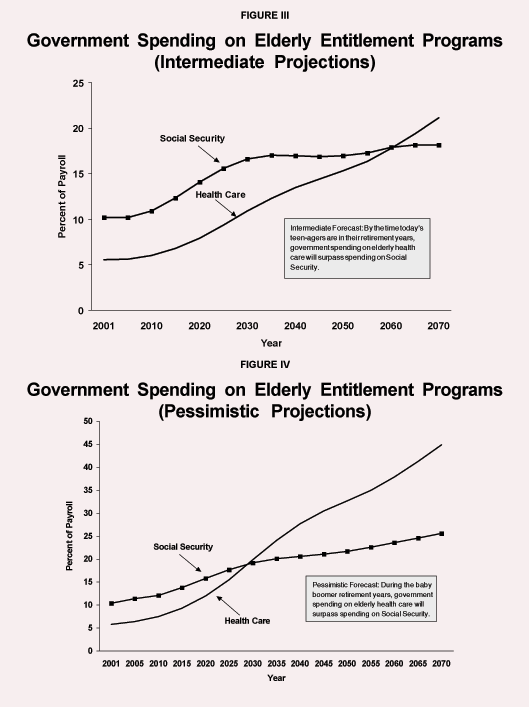
Rethinking the Assumptions about Health Care. In 1998 the NCPA made projections based on the Social Security and Medicare trustees' 1997 reports. The conclusion:5
- Based on intermediate assumptions, the burden of elderly entitlements will exceed 40 percent of taxable payroll by the middle of the 21st century.
- Based on pessimistic assumptions, the burden of elderly entitlements will exceed two-thirds of taxable payroll.
"By the time today's teens are in their retirement years, government spending on elderly health care will surpass spending on Social Security."
As bad as the current projections are, they are much better than the projections three years ago. What happened to improve the outlook? The answer is that in a single year, the Medicare trustees abruptly changed assumptions, wiping out almost one-third of Medicare's unfunded liability. As a result of these changes:6
- Predicted spending on Medicare in 2030 was reduced by an amount equal to 87 percent of the current program when scaled relative to the economy.
- For 2070 the trustees assumed away an amount of Medicare spending that exceeds the entire current program when scaled relative to the economy.
The Problem with Tax Collection. Social Security Administration and Health Care Financing Administration forecasts used for Figures I and II and Appendix Tables I and II are "static" forecasts that implicitly assume higher tax rates will generate increased government revenues with no change in economic behavior. For example, the forecasts assume that taxable payroll in the future will be the same, whether the tax rate is 15 percent or 55 percent. However, experience shows that in the face of higher tax rates, people work less and avoid or evade taxes more, which reduces economic growth.7
Escalating payroll taxes mean higher marginal tax rates for American workers. The Joint Economic Committee of Congress estimates that for each additional dollar the government increases its revenue, the private economy loses an additional 25 cents in lost goods and services.8 For example, if payroll tax rates were increased in an effort to raise revenue by $10 billion, taxpayers would actually be $12.5 billion worse off. Thus tax rates will have to be even higher than those presented here.
[page]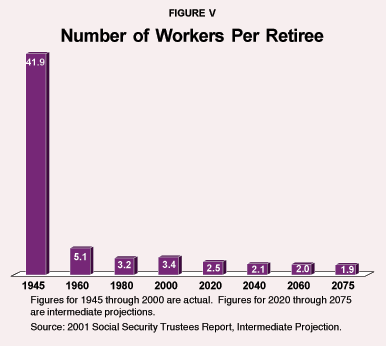
Why are Social Security and Medicare in trouble? One reason is that the number of retirees is growing faster than the number of new workers. The result is that the ratio of workers to retirees, which was 42 to 1 in 1940, is 3.3 to 1 today. By 2050, when today's college students reach retirement age, the ratio will be 2 to 1.9 [See Figure V.] The primary causes for this decline are a lower fertility rate and longer life expectancies. Exacerbating this problem is the expected growth of health care costs.
"When today's college students reach retirement age, there will be only two workers for each retiree."
The Fertility Rate. A country's fertility rate is the average number of children a woman of childbearing age will bear over her lifetime. To replace its population, a developed nation must have a fertility rate of about 2.1, assuming net immigration is zero and assuming constant death rates. In other words, to keep the population at its current size each woman must have an average of two children to replace one adult male and one adult female. (The additional 0.1 makes up for children who do not live to adulthood.)
"The fertility rate is the average number of children a woman of childbearing age will bear over her lifetime."
Currently, the U.S. fertility rate is about 2.07, and it has been as low as 1.8 (in 1976).10 Rising percentages of women who never marry, women who are divorced and young women who are in the labor force lead the Social Security trustees to predict a "continued relatively low fertility rate."11
"The U.S. fertility rate is about 2.07"
Other developed nations are experiencing the same decline in fertility rates. While the world as a whole has a fertility rate of 2.82, the rate for developed nations is 1.57 and the rate for Europe is 1.41.12 [See Figure VI.] Germany is at 1.33 and Italy (a Catholic country) is at 1.2.
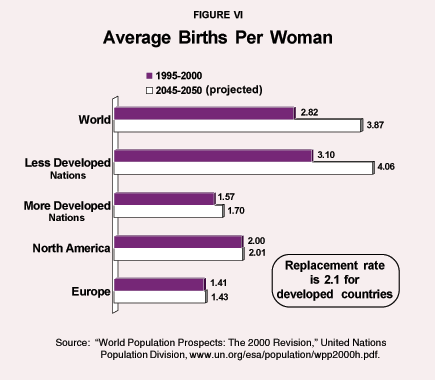
As Table I demonstrates, the Social Security trustees' intermediate fertility rate projection is a constant 1.95 into the future. The pessimistic projection is that the rate will fall to 1.7. The implication of either assumption is that the U.S. will eventually see its population shrink. [See Figure VII.] Along the way, the number of old people relative to the number of young will grow continuously, and the tax burden on the young will continue to grow indefinitely. For example:13
- Between now and 2050, the number of elderly will grow by 117 percent while the number of workers increases by only 24.6 percent.
- The elderly will grow from 12.4 percent of the population today to 20 percent by 2050.
"Between now and 2050, the number of elderly will grow by 117% while the number of workers will increase by only 25%."
Life Expectancy. In addition to falling birthrates, longer life expectancies are driving down the worker/retiree ratio. In 1940, the year Social Security paid its first benefit check, life expectancy at birth was 61.4 years for men and 65.7 years for women.14 The average male could expect to pay taxes over his entire work life and die 3.6 years before he qualified for benefits. The average female could expect to collect benefits for only a few months. Reaching the retirement age of 65 in 1940 was viewed as unusual. Supporting the few people who did seemed easily affordable.
"Retirees will live longer in retirement and collect more Social Security Benefit checks."
Things have of course changed. Life expectancy at birth today is 73.8 years for a male and 79.5 years for a female.15 The average man will spend about seven years in retirement (collecting Social Security benefit checks) and the average woman will spend about 12 years. And the Social Security trustees expect life expectancy to increase even further in the future. By 2050, when today's college students reach retirement age, life expectancy at birth will be 79 years for a male and 83.3 years for a female.16 Of course, longer life expectancies mean future retirees will live longer in retirement and collect more Social Security benefit checks.
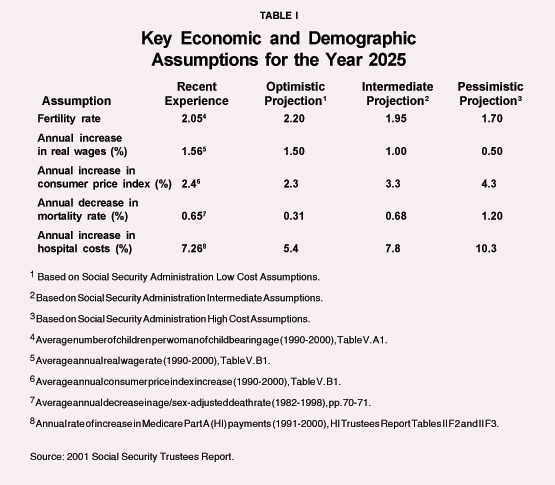
Medical Science. One of the factors contributing to the increase in life expectancies is advancement in medical science. As people get older they consume more health care. Although the elderly currently constitute only 12 percent of the population, they account for more than 44 percent of all health care spending.17 That number will increase as the population continues to age. In addition, medical breakthroughs contribute to escalating medical costs for senior citizens. Even with existing technology, health care for the elderly will be expensive. And who can imagine what treatments and cures will be effected in the future? Fifty years ago, no one could have imagined the medical procedures that are commonplace today. Similarly, we cannot predict what medical science will achieve over the next 50 years. As diseases are eradicated and new treatments are developed, the cost of medical care will continue to increase.

"All payroll tax revenues are spent–the very minute, the very hour, the very day they are received by the U.S. Treasury."
The U.S. Social Security system – like most government-sponsored retirement programs in the world today – is pay-as-you-go. All payroll tax revenues are spent – the very minute, the very hour, the very day they are received by the U.S. Treasury. Most of these revenues are spent on benefits for current retirees. Any additional amount is spent in other ways. But there is no funding of future benefits. No money is being stashed away in bank vaults. No investments are made in real assets.
What Happens When Social Security Has Surpluses and Deficits? These are normal features of any pay-as-you-go system. In the United States, payroll tax collections have exceeded benefit payments since the mid-1980s, and will continue to do so until 2016, when Social Security will begin running deficits again. For example:
- In 2001 the government will collect $604.3 billion from workers through the Social Security payroll tax and will spend $438.9 billion on Social Security benefits; thus the Social Security surplus in 2001 will be $165.4 billion.
- At the end of 2001, the accumulated value of all the previous years' surpluses will total more than $1.2 trillion.
- By 2016 the government will have collected more than $5.4 trillion in Social Security surpluses.
Where is all this money going? In years when Social Security runs a surplus, amounts not used to pay benefits to current retirees are spent by the federal government on other programs or (very recently) to pay down publicly held government debt. For example, much of the 2001 Social Security surplus will be spent on defense issues or economic stimulus as a result of the attacks on September 11, 2001. In years when the system runs a deficit, more is spent on benefits than is collected in payroll taxes and the government uses other tax revenues, mainly individual and corporate income taxes, or borrows to make up the difference.
What Is the Social Security Trust Fund? Most pay-as-you-go systems do not have trust funds, since there are no investments for the trust funds to make. In the United States, we have trust funds – but they serve an accounting function, not a financial function. For example, the Social Security (OASI) trust fund keeps track of surpluses and deficits in retirement, spousal and survivors benefits over time; the Disability Insurance (DI) Trust Fund tracks disability benefits; the Health Insurance (HI) Trust Fund tracks Medicare Part A benefits and the payroll tax that funds those benefits.
But these trust funds do not collect taxes. Nor do they disburse benefits. Every payroll tax check sent to Washington is written to the U.S. Treasury. Every Social Security benefit check is written on the U.S. Treasury.
"The trust funds' special issue bonds are actually nothing more than IOUs the government writes to itself."
Don't the Trust Funds Hold Government Bonds? Yes and no. Technically, the trust funds hold bonds that represent the cumulative surplus (payroll tax collections minus benefit payments). But these bonds are important only for accounting purposes. They have no financial significance and, like bookkeeping entries, no market value. The annual reports of the Social Security trustees list the yields and maturity dates of the special-issue bonds in the Social Security trust fund. But these special-issue bonds are not the same as the bonds held by the public. They are not part of the official outstanding debt of the U.S. government. They cannot be sold on Wall Street or to foreign investors. And they cannot be used to pay benefits.
Moreover, the Social Security trust fund exists within the U.S. Treasury – not as an independent entity. The issuer of the bonds (the U.S. Treasury) and the holder of the bonds (the Social Security trust fund) are the same entity. Thus the trust fund's special-issue bonds are actually nothing more than IOUs the government writes to itself.
On paper, the trust fund has enough IOUs to "pay" Social Security benefits for about 28 months on any given day. In reality, it cannot pay anything. Every asset of the trust fund is a liability of the Treasury. Summing over all government accounts, the balance is zero. For the Treasury to write a check, it must first tax or borrow.
The actual certificates for the trust fund's special-issue bonds are held in government filing cabinets in Parkersburg, W.Va. But if the building were to burn down or thieves were to steal the filing cabinets, there would be no harmful consequences for retirees. Similarly, if the trust funds were abolished, real economic activity would be unaffected. Private bondholders would not suffer, and the government would retain its existing obligations and commitments. Alternatively – as the late economist Robert Eisner suggested – with the stroke of a pen, we could double or triple the number of IOUs the trust fund holds. Either option would allow us to dispense with artificial crises and address the real problem: How is the Treasury going to pay the government's bills?
What's the Problem? Social Security will begin running annual deficits by 2016. At that time, the value of all the IOUs held in the trust fund will total $5.4 trillion. Where will the government get the extra $5.4 trillion to pay back the IOUs? Congress will have only three options: raise taxes, cut benefits or borrow. Ironically, these are the same choices the government would face if there were no trust fund at all.
[page]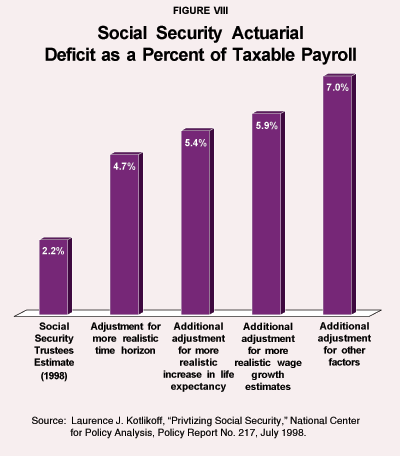
If we decide to keep the current system, we will either have to increase taxes, cut benefits, cut other government spending or incur increasing debt in an attempt to pass our burden onto future generations. A number of people have suggested we do each of these. What follows is a brief summary of some of the proposals.
"Raising taxes would work only if Social Security were converted to a funded system."
Raising Taxes: The 2 Percent Solution. The 2001 Social Security Trustees Report says Social Security's 75-year actuarial deficit can be eliminated by an immediate and permanent payroll tax increase of 1.86 percentage points. Such an idea is sometimes called the "2 percent solution."
But according to Boston University Professor Larry Kotlikoff, even if we accept the reasoning behind this idea, what we really need is a 7 percent solution.18 That's because the Social Security Trustees Report discloses only about a third of the system's actual long-run fiscal imbalance.19 [See Figure VIII.] According to Kotlikoff:
-
To ensure promised benefits not just for 75 years but indefinitely, the payroll tax would have to be raised by 4.7 percentage points.
-
Using more realistic assumptions for life expectancy would raise the needed tax increase from 4.7 to 5.4 percentage points.
-
Using more realistic wage assumptions raises the needed tax hike to 5.9 percentage points.
-
Using more realistic assumptions for additional factors like fertility and net migration may require a 7 percentage point immediate and permanent tax hike, putting the total tax rate at 19.4 percent.
But even this does not solve the problem unless the surpluses are invested in real assets. If the larger revenues generated by the increased payroll tax are spent on other programs, as they have been in the past, the funds will be unavailable to pay benefits. Put another way, the "2 percent/7 percent" solution works only if we begin to convert from a pay-as-you-go system to a funded system.
Raising the Retirement Age. The "normal retirement age" is currently set at 65; but for those born in 1938 and later, the retirement age will increase by two months each year until it reaches 67 for anyone born after 1960. Some want to go further, increasing the retirement age to 70 and indexing it to increases in life expectancy. The Social Security Advisory Board estimates this would pay 32 percent of the program's long-term deficit.20
But there are several problems with this idea. First, even though life expectancies overall are increasing, minorities have shorter life expectancies and raising the retirement age will hurt them disproportionately. For example, the life expectancy at birth for an African-American male is 64.6 years.21 Even with a normal retirement age of 65, an African-American male can expect to pay taxes over his entire working life and die a few months before qualifying for benefits. With a retirement age of 70, his likelihood of receiving benefits becomes even lower. Second, asking blue-collar workers who toil long years at physically demanding jobs to work even more years may be unreasonable. Almost everyone who talks about raising the retirement age to 70 is wearing a white collar.
"The long-term deficit in Social Security is 3 times greater than what the trustees estimate."
Finally, raising the retirement age ignores the trend toward earlier retirement. Americans are leaving the workforce earlier, at an average age of 62.2 years, down from 64 years in 1973.22 If this trend continues, raising the retirement age means widening the gap between the actual age of retirement and the age at which full Social Security benefits are paid. It begs the question of how most people are going to fund their retirement expenses.
Reducing or Eliminating Benefits for Higher-Income Workers. Some have suggested means testing benefits and even eliminating benefits for higher-income earners. After all, why should millionaires receive Social Security? However, there aren't that many millionaires. So in order for means testing to reduce benefit payments significantly, it must reach much lower levels of income. For example, the Social Security Advisory Board says means testing can reduce Social Security's long-term deficit by 89 percent, but only with benefit reductions for families with annual incomes as low as $40,000.23
"Patchwork reforms do not address the underlying structural problem."
Taxing Untaxed Wages. Only about 84 percent of all covered earnings are taxed.24 Does it make sense to tax the other 16 percent? There are reasons not to. For example, about half of untaxed income is in the form of fringe benefits such as health insurance and pensions. These are not taxed because government has an interest in encouraging private health insurance and private pensions. The other half of untaxed wages consists of income above the maximum taxable wage, which is $80,400 in 2001. But applying FICA taxes to all income would lead to very high marginal tax rates for wealthier taxpayers and might not produce any extra revenue. The highest-income taxpayers already face a 42.5 percent marginal tax rate (39.6 percent income tax rate plus 2.9 percent Medicare payroll tax). Add Social Security payroll taxes and the marginal tax rate would be about 54.9 percent. As mentioned earlier, the economic disincentives associated with higher marginal tax rates encourage evasion and discourage investment and growth.25
Taxing Benefits. Some have suggested raising taxes on Social Security benefits as one way to offset some of Social Security's financial shortfall. Social Security benefits are already taxed under current law:
- Taxes are imposed on up to 50 percent of benefits for single retirees with modified adjusted gross incomes over $25,000 and for couples with incomes over $32,000.
- Single retirees with incomes above $34,000 and couples with incomes over $44,000 must pay taxes on up to 85 percent of their incomes above this threshold.
Moreover, the Social Security benefits tax is only nominally a tax on benefits. In reality, it uses Social Security benefits as an excuse to tax other income and does so in an inefficient way. For example, if a retiree is below the first threshold, there is no tax. However, above the threshold, each dollar of interest, dividends or wages increases taxable income by $1.50. So if the retiree is in, say, the 28 percent tax bracket, the additional tax on a dollar of income is 42 cents ($1.50 x 0.28) – in essence a 42 percent marginal tax rate.
"The Social Security benefits tax is in reality a tax on other income."
If a retiree is above the second threshold, each additional dollar of income raises taxable income by $1.85. Thus the retiree is in the 28 percent tax bracket and the tax rises by 52 cents for each additional dollar earned – effectively a 52 percent marginal tax rate. Moreover, if the income is wage income, each additional dollar also faces payroll taxes, increasing the marginal tax rate to 64 percent!26
As noted above, higher marginal tax rates are extremely wasteful. And extending the current approach to reach more retirees would impose a huge economic cost relative to any possible benefit.
There are of course more efficient ways of taxing benefits. For example, some or all of Social Security benefits could be included in the taxable income of retirees. This approach would subject benefits to taxation without raising marginal tax rates. But it also would diminish the retirement income of many of the very people Social Security was created to help.
Reduce Benefits for Future Retirees. There are several different ways to reduce benefits for future retirees. As discussed above, one way is to raise the retirement age. Another is to reduce the annual cost-of-living adjustment (COLA), the formula Social Security uses to increase benefits to adjust for the effects of inflation. Reducing the COLA would mean that benefits would rise less each year, leading to lower benefits for future retirees in real terms. A third idea is to alter the formulas the government uses to calculate benefit amounts so that retirees would get a smaller benefit each month.27 However, balancing the system through benefit cuts alone eventually would require cuts of nearly one-third.28
[page]Social Security will run annual surpluses from now until 2016. There are two primary options for using these surpluses. First, the funds could continue to be spent or used to pay down publicly held debt, which is now happening under current law. The second option is to invest the surpluses in assets. This second approach would create a partially-funded system that would be integrated with the current pay-as-you-go system, creating essentially a two-tiered approach to provision of retirement security.
On the positive side, paying down the debt allows the government to avoid making interest payments. However, this option does nothing to solve the long-term demographic and structural problems of the system. NCPA Senior Fellow and Social Security Trustee Thomas S. Saving, along with colleagues Andrew J. Rettenmaier and Liqun Liu of Texas A&M University's Private Enterprise Research Center, have calculated the long-term consequences of this approach:29
- By 2012, all publicly held federal debt will be paid off.
- But because all of Social Security's structural problems will remain, the government will have to start borrowing again by 2022.
- By 2029, the U.S. will have the same debt as it does today.
At that time, the government will have to make a decision: Keep borrowing or raise taxes:30
- If the government keeps borrowing, by 2050 it will have four times more debt than if the surplus were used to finance personal accounts.
- If the government raises taxes, then by 2050 the payroll tax will have to rise 7.2 percentage points to 19.6 percent.
By contrast, if the Personal Retirement Account (PRA) plan is adopted, the debt will be roughly the same as today and payroll taxes will be about the same as under current law. If the Social Security surplus is used to fund PRAs, the payroll tax will have to be increased only 0.1 percentage point to 12.5 percent.31 This is possible because future retirees will draw an increasing amount of their retirement benefits from their personal accounts and the government's Social Security expenditures will be reduced.
[page]The alternative to funding retirement benefits by income transfer is to fund them through savings. The alternative to creating escalating burdens for each successive generation of workers is for each generation to save for its own retirement benefits and pay its own way. This approach is rational, as shown by international precedents.
"Some countries have reformed their pay-as-you-go systems."
Retirement Security Reform in Other Nations. Like Social Security, the vast majority of the world's retirement security systems are pay-as-you-go. Not only do they face the same demographic problems we face, but most of the developed countries are in worse shape. To reiterate: by the time today's college students reach retirement age (in 2050) our elderly will make up 20 percent of the population – compared with only 12 percent today.32 Other developed countries are facing the same population crisis as the U.S., but to a greater degree. For instance, Italy and Germany will have only one worker for every retiree by 2030.33
Some countries have already reformed their pay-as-you-go systems to deal with these emerging demographic trends, laying a course for other nations to follow. Among the notable alternatives to pay-as-you-go retirement security are the following:
- In May 2001, the German Parliament adopted a plan to partially privatize a portion of its pay-as-you-go national retirement system. The plan encourages workers to invest up to 1 percent of their wages in private pension plans beginning in 2002 and up to 4 percent beginning in 2008.34
- Chile paved the way for reform in 1981 when it transformed its pay-as-you-go system into a system that requires workers to invest in individual retirement accounts, managed by private funds that must invest in a diversified portfolio of assets.
- Seven other Latin American nations have adopted the Chilean model to some degree, including Peru (1993), Argentina (1994), Colombia (1994), Uruguay (1995), Bolivia (1997), Mexico (1997) and El Salvador (1998).35
- Britain allows employers and workers to opt out of the state pension system's second tier by setting up private pension plans with benefits at least as generous as the government system.36
- Singapore's Central Provident Fund (CPF) requires employees and employers to contribute jointly to individual accounts, which may be used not only for retirement and for hospital expenses but also to finance college tuition or purchase a home.
- Several start-up systems are based on the Chilean model, including those in Hong Kong, Hungary, Poland and Kazakhstan.
Advisory Council Proposals.37 A 13-member bipartisan Advisory Council on Social Security, appointed by the Clinton administration, recognized that the stock market historically has provided returns two or three times higher than those from government securities. However, the council couldn't agree on a single approach to Social Security reform, and instead proposed three different ones, none of which was supported by a majority of the council.
"Several proposals would allow individuals to invest through personal retirement accounts."
One proposal would have the government invest 40 percent of the Social Security trust fund – an inflation-adjusted $800 billion – in the stock market over 15 years. Investments would be in a broad range of stocks much like stock-index funds, and the government would not vote its shares. But politicians would be tempted to try to influence investments that would control as much as 10 percent of the nation's equities. They would almost certainly try to use their control to encourage or discourage certain industries, achieve social goals, reward friends or punish enemies. Critics note that this is what has happened with similar plans in Sweden and Japan.
The other two proposals envisioned individual investments in the equities markets. One would allow individuals to invest 5 percentage points of the 12.4 percent payroll tax in Personal Savings Accounts for retirement. The other would increase the Social Security payroll tax by 1.6 percentage points, allowing individuals to invest the amount of the increase in their personal retirement accounts.
"We need to replace Social Security with a system under which each generation pays its own way."
Public Support for Reform. While Social Security is popular, much of the public recognizes that the system cannot be sustained. Social Security reforms that include personal retirement accounts have been popular with the public and with politicians of both parties. President George W. Bush grabbed hold of the fabled "third rail of American politics" and survived to tell about it – despite incessant attacks from his political opponents. Reform plans have been proposed by Members of Congress from both parties and both houses. Recent evidence indicates that former President Bill Clinton was holding regular meetings with financial experts to examine the feasibility of personal accounts as a fix for Social Security.38 In addition, polls consistently show that Americans are in favor of the concept of personal retirement accounts.
[page]Because of Social Security's demographic and structural problems, it will soon fall on hard times. Demographic realities are forcing America and other developed nations to rethink taxpayer-financed pay-as-you-go programs that require current workers to finance benefits to the elderly. If we attempt to maintain the current system, it will require astronomical tax rates from future workers or painful benefit cuts for future retirees. The budget surplus and the direness of Social Security's long-term problems provide the incentive and opportunity to develop a meaningful solution.
NOTE: Nothing written here should be construed as necessarily reflecting the views of the National Center for Policy Analysis or as an attempt to aid or hinder the passage of any bill before Congress.
[page]- Liqun Liu and Andrew J. Rettenmaier, "Social Security and Race," National Center for Policy Analysis, NCPA Policy Report No. 236, October 2000.
- Based on official forecasts by the Social Security Administration and the Health Care Financing Administration (now called the Centers for Medicare & Medicaid Services), as presented in the 2001 Annual Report of the Board of Trustees of the Federal Old-Age and Survivors Insurance and Disability Insurance Trust Funds (referred to as the 2001 Social Security Trustees Report), the 2001 Annual Report of the Board of Trustees of the Federal Hospital Insurance Trust Fund and the 2001 Annual Report of the Board of Trustees of the Federal Supplementary Medical Insurance Trust Fund.
- Students beginning their first year in college during the 2001-2002 school year were born in 1983 and are currently 18 years old. This cohort will reach normal retirement age (67 years old) in 2050.
- Health care spending on the elderly by government programs other than Medicare is assumed to continue at 36.3 percent of Medicare spending. The NCPA calculated this number using figures for Medicare and Medicaid from "Health Care Financing Review: Medicare and Medicaid Statistical Supplement, 1999," Health Care Financing Administration. Figures for other elderly health spending, including Veterans Affairs and other programs, were drawn from "Medicare 2000: 35 Years of Improving Americans' Health and Security," Health Care Financing Administration, July 2000, Figure 10.
- John C. Goodman and Dorman E. Cordell, "The Nightmare in Our Future: Elderly Entitlements," National Center for Policy Analysis, NCPA Policy Report No. 212, January 1998.
- Laurence J. Kotlikoff, "Is War between Generations Inevitable?" National Center for Policy Analysis, forthcoming study.
- Budget Options, Congressional Budget Office, Chapter 6, February 2001. Available online at http://www.cbo.gov/showdoc.cfm?index=2731&sequence=23&from=5.
- Chris Edwards, Economic Benefits of Personal Income Tax Rate Reductions (Washington, D.C.: U.S. Congress, Joint Economic Committee, April 2001). Available online at http://www.house.gov/jec/tax/taxrates/taxrates.pdf.
- 2001 Social Security Trustees Report, Table VI.A1. pp. 115-116.
- 2001 Social Security Trustees Report, Table V.A1. p. 73.
- 2001 Social Security Trustees Report, p. 70.
- World Population Prospects: The 2000 Revision, The United Nations Population Division, Table 2.
- Social Security Trustees Report, Table V.A2.
- Social Security Trustees Report, Table V.A3
- Ibid.
- Ibid.
- Health Care Financing Review: Medicare and Medicaid Statistical Supplement, 1999, U.S. Department of Health and Human Services, Health Care Financing Administration, Table 1, p. 89.
- Laurence J. Kotlikoff, "Privatizing Social Security," National Center for Policy Analysis, NCPA Policy Report No. 217, July 1998.
- Ibid
- "Social Security: Why Action Should Be Taken Soon," Social Security Advisory Board, July 2001. The Social Security Advisory Board makes several assumptions that causes them to overstate the percent of Social Security deficit resolved by various methods. First, they assume that the trust fund is solvent and holds real assets, so the deficit will be increased by one-fourth in order to redeem the IOUs in the trust fund. Second, the board's calculations only save the system until 2075. Each year after 2075 will add additional costs to the program and increase the long-term deficit.
- Population Projections of the United States by Age, Sex, Race and Hispanic Origin: 1995 to 2050 – Middle Series, Vital Rate Inputs, U. S. Bureau of the Census, Population Division (1996). Table B-1. By contrast, the life expectancy for a white male is 74.2 years.
- W. Michael Cox and Richard Alm, Myths of Rich and Poor: Why We're Better Off Than We Think (New York: Basic Books, 1999), p. 56.
- Social Security Advisory Board, p. 25.
- Social Security Advisory Board, p. 23.
- See Martin Feldstein, "The Missing Piece in Policy Analysis: Social Security Reform," National Bureau of Economic Research, Working Paper 5413, January 1996. Also see Chris Edwards, Economic Benefits of Personal Income Tax Rate Reductions (Washington, D.C.: U.S. Congress, Joint Economic Committee, April 2001). Available online at http://www.house.gov/jec/tax/taxrates/taxrates.pdf.
- Stephen J. Entin, "Reducing the Social Security Benefits Tax," National Center for Policy Analysis, NCPA Brief Analysis No. 332, August 10, 2000.
- An average indexed monthly earning (AIME) is calculated for each worker, which includes all the Social Security taxes the worker paid each year from 1951 to the present. This amount is indexed for inflation. From these annual earnings, the worker's highest-earning 35 years are selected, added and divided by 420 (the number of months in 35 years). This monthly number is the worker's AIME. Next, each worker's primary insurance amount (PIA) is calculated, which is the basic monthly benefit the worker will receive. It is derived from the worker's AIME by applying a progressive benefit formula. The PIA is indexed for inflation through annual cost-of-living increases (COLAs). The formulas are skewed so that lower-income people receive a higher benefit relative to the amount of taxes they paid in than higher-income people. The formula could be altered by expanding the 35-year limit to include more lower-earning years, thus reducing the average earnings and therefore benefits. In addition, the PIA formula could be rewritten to replace less of a worker's preretirement income, thus decreasing monthly benefit payments.
- NCPA calculations based on the 2001 Social Security Trustees Report.
- Liqun Liu, Andrew Rettenmaier and Thomas Saving, "Saving the Surplus," National Center for Policy Analysis, NCPA Policy Report No. 241, January 2001.
- Ibid.
- Ibid.
- 2001 Social Security Trustees Report, Table V.A2. p. 75.
- Anne Swardson, "Pensions Threaten European Economies," Washington Post, April 26, 2000, p. A1.
- The White House Bulletin, "Germany Adopts Plan to Partially Privatize National Retirement System," Bulletin News Network, Inc., May 11, 2001.
- Luis Larrain, "Privatizing Social Security in Latin America," National Center for Policy Analysis, NCPA Policy Report No. 221, January 1999.
- Peter J. Ferrara, John C. Goodman and Merrill Matthews Jr., "Private Alternatives to Social Security in Other Countries," National Center for Policy Analysis, NCPA Policy Report No. 200, October 1995.
- Report of the 1994-1996 Advisory Council on Social Security, Vol. I: Findings and Recommendations, Washington, D.C., 1997.
- Glenn Kessler, "Clinton Eyed Private Social Security Accounts," Washington Post, June 28, 2001, p. A6.
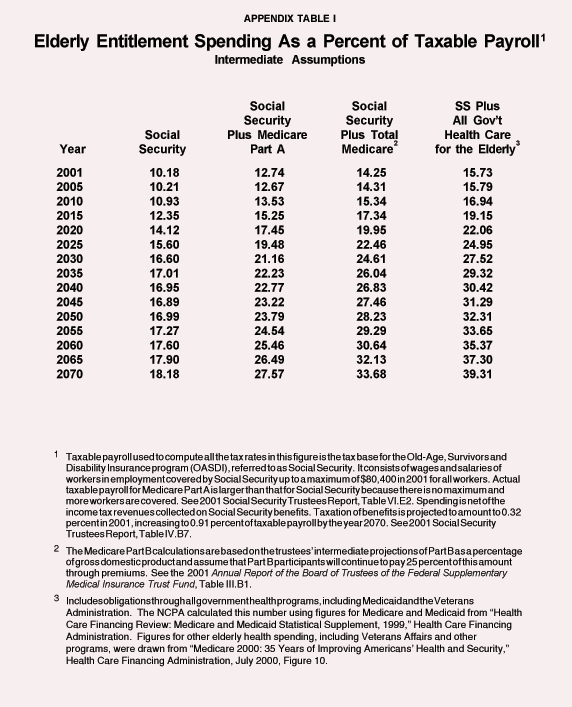
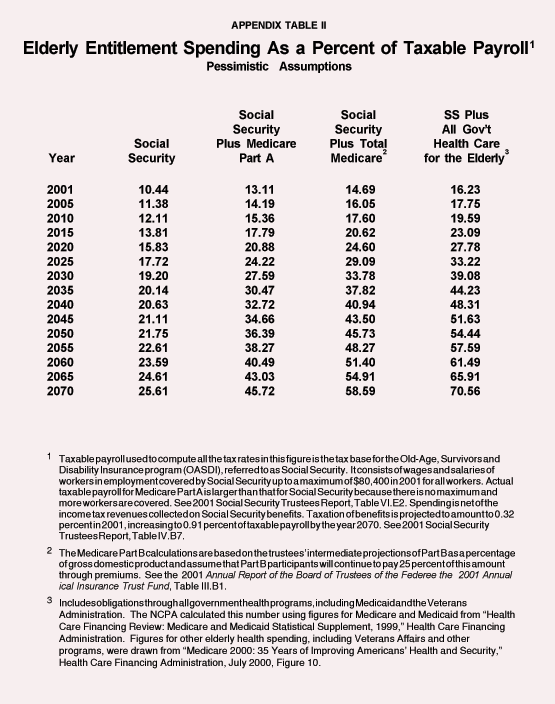
John C. Goodman is President of the National Center for Policy Analysis. Dr. Goodman earned his Ph.D. in economics at Columbia University and has engaged in teaching and research at six colleges and universities, including Columbia University, Stanford University, Dartmouth College, Sarah Lawrence College and Southern Methodist University. Dr. Goodman has written widely on health care, Social Security, privatization, the welfare state and other public policy issues. He is the author of seven books and numerous scholarly articles. Dr. Goodman's published works include National Health Care in Great Britain, Regulation of Medical Care: Is the Price Too High?, Economics of Public Policy, Social Security in the United Kingdom and, with Gerald L. Musgrave, Patient Power: Solving America's Health Care Crisis.
Matt Moore is a policy analyst with the National Center for Analysis, focusing on Social Security and education policy. He is also responsible for maintaining "Social Security Central," the NCPA's Social Security Web site at www.mysocialsecurity.org. Mr. Moore has B.A. degrees in political science and corporate communications and public affairs from Southern Methodist University and a Master's degree in public policy from Georgetown University.